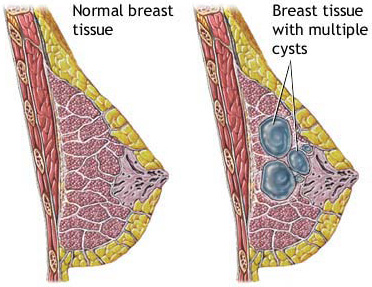Breast Disease

Benign Breast Lumps
- Breasts are made up of ducts, lobes, fibrous tissue, and underlying bone; therefore, they can feel lumpy or uneven. Before your menstrual period begins, and sometimes during your period, you can have some tenderness, pain, or lumps in your breasts. This could be due to the extra fluid that collects in the breast tissue (cyst) and changes in the body's hormonal levels. This is normal. But if the lumps do not disappear before your next period, contact your doctor as soon as possible.
- Any noticeable change, thickening, or localized swelling in your breast that was not there before maybe a lump. Eighty-five percent of all breast lumps found are benign. Some common mild breast problems that appear as lumps are:
Nipple Discharge
- Many women will have during their lifetime a nipple discharge. It can be either in one breast or both. Most nipple discharges are not serious. A clear nipple discharge is considered normal and will not require further workup most of the time. If it persists or increases, your physician will probably want to investigate the matter further. A bloody nipple discharge is different. Although most women with a bloody nipple discharge will be found to have a benign tumor inside one of the milk ducts (intraductal papilloma), it has to be proven. A bloody nipple discharge can occasionally be the symptom of breast malignancy and should be thoroughly investigated. Some surgeons will first order a Galactrography, which is an X-ray of the breast's ductal system. This may help clarify the cause of the discharge. Most of the time, a breast biopsy is warranted to obtain the diagnosis.
Malignant Breast Lumps
- Malignant lumps develop most often from mammary ducts or lobules. Unlike benign lumps, malignant nodes continue to grow uncontrollably and, in time, if left untreated, will spread beyond the breast. The basic structure of the breast is composed of:
- Lobules, which when appropriately stimulated, will produce and secrete milk,
- Ducts, which carry the milk from the lobules to a network of ducts and then eventually to the nipple, and
- Supporting tissue: Breast cancer can arise from each of these structures. The most common site is the ducts and secondarily is the lobules. The terminology of ductal carcinoma and lobular carcinoma is derived from the location of their origin.
- When breast cancer begins within the ducts of the breast, this is referred to as intraductal carcinoma in situ (DCIS), and it is considered to be the earliest detectable stage of breast cancer. The most common progression of DCIS is that it may, and in most cases, will become an invasive carcinoma. It will go beyond the duct into the breast tissue. Once this has spread through the breast, it will spread to the lymph nodes. It may spread from the lymph nodes to other parts of the body, such as the bones, lungs, liver, or brain.
- If the breast cancer originates in the breast's lobules, it is called lobular carcinoma in situ (LCIS). The evolution of this cancer is similar to DCIS, but it has specific characteristics. These characteristics are:
- It is not as aggressive as DCIS, and
- It is viewed as a marker for breast cancer. This means that patients found with LCIS they are at increased risk of developing cancer in both breasts.
- Other forms of breast carcinoma are not discussed in this setting because of their rare occurrence.
- Early breast cancer can be a nonpalpable lesion or a very small tumor located within the breast. Breast cancer most likely has been growing for several years before it is large enough to be felt. Women who examine their breasts each month, go to their breast disease specialist for routine breast examinations, and after age thirty-five have a baseline (your first) mammogram, are more likely to detect early breast cancer.
- Advanced breast cancer is a tumor spread beyond the breast to the lymph nodes or another part of the body. Cancer cells break off from the primary tumor and are carried in the lymphatic system and/or the bloodstream to a distant part of the body, growing into a new tumor or metastasis.
- Home
- About Dr Rishma Pai
- Profile
- Memberships
- Awards & Honours
- Articles
- Photo gallery
- Social Commitment
- Testimonials
- Resources
- Blog
Dr Rishma Pai strives to be amongst the top gynaecologist and obstetrician in Mumbai. Patients across the world seek second opinion from Dr Rishma Pai on Fibroids treatment, Endometriosis treatment, advanced infertility, endoscopic surgery, hysterectomy, surrogacy in Mumbai, recurrent miscarriage, recurrent ivf failures and menopause.
© All rights reserved. Dr. Rishma Dhillon Pai. 2008 - 2019.
Privacy Policy |
Terms of use



 Book an Appointment
Book an Appointment

